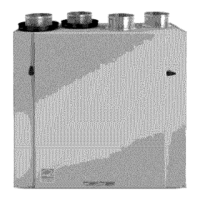
Do you have a question about the Carrier HRVXXSVU1157 and is the answer not in the manual?
| Model Number | HRVXXSVU1157 |
|---|---|
| Brand | Carrier |
| Category | Fan |
| Type | Heat Recovery Ventilator |
| Voltage | 120V |
| Phase | 1 |
| Frequency | 60 Hz |
| Motor Type | ECM |
Follow all safety codes, wear protective gear, and have a fire extinguisher.
Explains DANGER, WARNING, CAUTION, and NOTE signal words.
Explains the function and purpose of the HRV unit.
Instructions to inspect the unit for damage after unpacking.
Recommendations for placing the HRV unit in a conditioned space.
Lists hazards like injury, shock, property damage, and improper use.
Lists cautions for equipment damage or improper operation.
Illustrates normal operation and details defrost cycle parameters.
Provides dimensional drawings and specifications for the unit.
Details installation for homes with radiant hot water or electric baseboard heat.
Describes connection to a forced air system via registers.
Explains connection to a forced air system's return or supply duct.
Instructions to inspect the unit and its packaging for damage.
Steps for relocating the unit door for maintenance access.
Guidelines for choosing an appropriate location for the HRV unit.
Method for determining the correct duct size for airflow.
Details on installing stale air exhaust and fresh air ducts.
Instructions for connecting to furnace supply/return ducts.
Connects fresh air port to furnace supply duct.
Connects fresh air port to furnace return duct.
Connects exhaust port to furnace return duct.
Details on connecting to furnace for fresh air distribution.
Procedure for connecting insulated flexible ducts to unit ports.
Using metal screws and tape for rigid ducts, tie wraps for flexible.
Guidelines for choosing location and installing intake/exhaust hoods.
Procedure for connecting the drain tube and creating a water trap loop.
Describes the 30-second booting sequence upon power up.
How to operate the unit using the push button and LED indicator.
Procedure to set the unit to extended defrost in cold regions.
Instructions for wiring optional main wall controls.
Wiring optional dehumidistat, timer, or push-button switches.
Instructions for connecting the unit to a furnace's 24-volt system.
Specific wiring for furnaces connected to a cooling system.
Presents the complete wiring diagram for the unit.
Illustrates the unit's logic and control flow.
Details on how to select fan speeds and their corresponding CFM.
Lists required tools like a magnehelic gauge and plastic tubes.
Steps before balancing, like sealing ducts and opening dampers.
Detailed steps for adjusting dampers and matching CFM values.
Diagram showing all components of the unit.
Table listing all available service parts and their quantities.
Explains LED flashes and their corresponding unit status.
Details specific problems, causes, actions, and unit status.
Table showing Ohm values for various temperatures for the thermistor.
